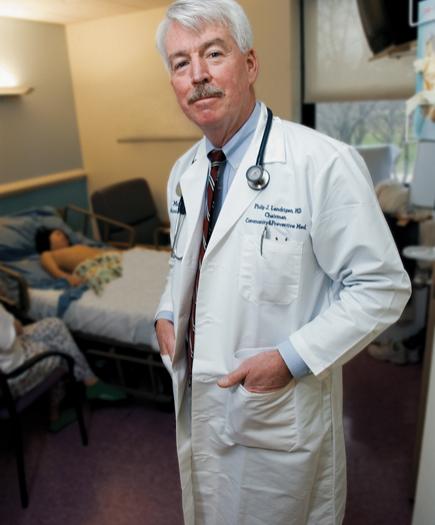The Power of Public Health Epidemiology

Claims to Fame
Ethel H. Wise Professor of Pediatrics and Chair, Department of Preventive Medicine; Director, Children’s Environmental Health Center; Dean for Global Health, Icahn School of Medicine at Mount Sinai; former lead investigator, New York Vanguard Center, National Children’s Study.
Refresher Course
When Philip Landrigan ’67 arrived in Atlanta in 1970, he was a newly minted pediatrician with Boston roots who knew nothing about epidemiology. Landrigan had been chosen by the CDC, then the Communicable Disease Center, to serve the two years of national service required during the Vietnam conflict, and was assigned to the Epidemic Intelligence Service, a program that trains young doctors to become public health epidemiologists. “I figured I’d go to Atlanta for two years, fulfill this obligation, and return to academic pediatrics in New England,” he says. That’s not what happened.
Getting the Lead Out
Landrigan’s work in Boston with children who had paint-related lead poisoning led to an assignment to investigate reports of pediatric lead exposure in El Paso, Texas. The lead source, he found, was not paint; it was dust and soil contaminated by discharges from a smelting plant’s smokestack. Landrigan showed that this lead had eroded IQs and slowed reflexes even in children without symptoms of exposure. With this and other research confirming the toxic effects of low-level lead exposure in the environment, in 1975 Landrigan and colleagues persuaded the U.S. Environmental Protection Agency to remove lead from gasoline.
Gen Next
The El Paso findings spurred Landrigan to propose forming what is now the CDC’s National Center for Environmental Health. He later headed the National Academy of Sciences’ Committee on Pesticides in the Diets of Infants and Children, which laid the groundwork for the Food Quality Protection Act of 1996—the only federal pesticide law and the only federal environmental law with explicit standards to protect the health of children. That work fueled his organizing what would become the EPA’s Office of Children’s Health Protection, and to his tenure as chief investigator for the New York Vanguard Center of the National Children’s Study, launched in 2009. This longitudinal study will track environmental exposures and their influences on the health of 100,000 U.S. children in order to identify preventable risk factors.
Small Voices, Great Joy
“I think there’s something very joyous about working with children,” says Landrigan. His work, he says, has heightened his awareness of the links between social justice issues and environmental threats to health. “It bothers me greatly that within America environmental hazards fall most heavily on those who have the smallest voice.” Landrigan has successfully navigated the political system to make a real impact on children’s health, and he plans to continue to do so. “Just as they say, the price of freedom is unceasing vigilance; it’s no different in keeping the world healthy. It requires constant work.”
Image: Gary Wayne Gilbert